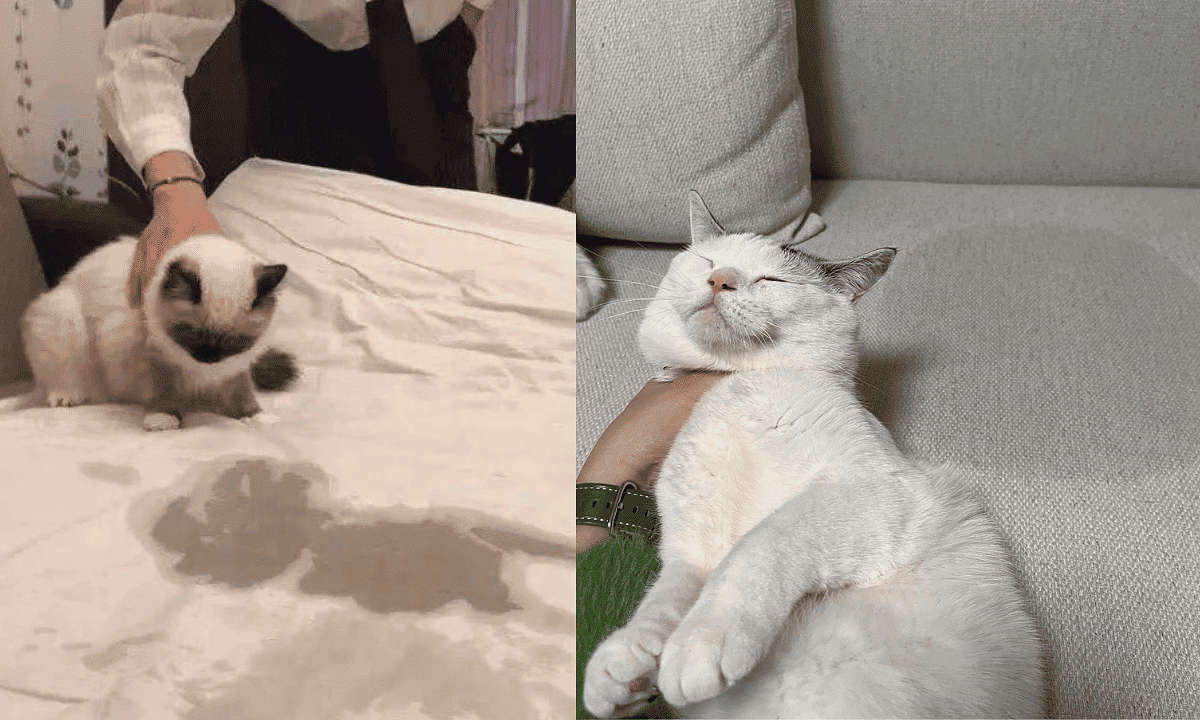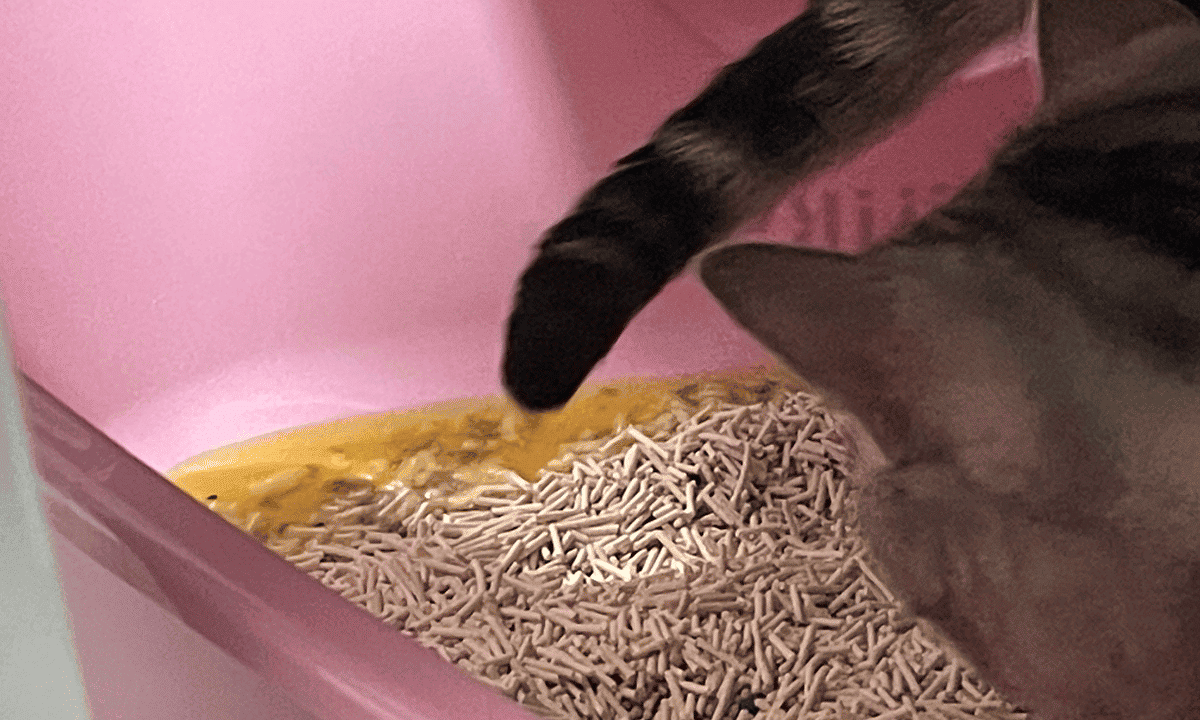Your Cart is Empty
How To Get Cat Pee Out Of The Couch
by Dr. Rebecca MacMillan BVetMed MRCVS July 12, 2023

Short answer: An enzymatic cleaning product is the best answer for getting cat pee out of soft furnishings.
However, I have a few other suggestions you can try too.
As well as tackling the stain, it’s also essential to explore why your cat might have peed on your couch in the first place.
As a vet in clinical practice, I see many cats that urinate in inappropriate places. Owners have reported finding cat pee on their bed, in the bathtub, on the door mat, and even in a handbag once!
There is usually an excellent underlying reason for this, some of which could be because of potentially serious health issues.
Read on to find the best way to help your cat with toilet troubles.
IN THIS ARTICLE
What Is Inappropriate Toileting

Inappropriate toileting describes when your cat is not using their litter tray (or going outside to the toilet) as usual.
They could be having ‘accidents,’ either toileting on the floor just outside of the tray or squatting in random places around the house.
It can be pretty frustrating if puddles of urine appear on your carpet or soft furnishings, but it’s essential to realize that an underlying health issue may be causing the problem.
This toileting type differs from spraying, where the cat backs up to a vertical surface to ‘mark their territory.’ Both males and females can do this, which is more common in cats that haven’t been neutered.
If cats are spraying<1>, this is usually an indication of sexual maturity, but stress and health issues can also cause cats to spray more often too.
What Causes A Cat To Toilet Inappropriately

There are several different reasons why your cat might be peeing in unusual places. These include –
Dirty litter tray
Cats are spotless animals; they might start toileting elsewhere if their tray isn’t cleaned often enough.
Wrong cat litter
A change in cat litter can cause some cats to stop using their tray. A different type of litter or an overly scented product could be off-putting.
Wrong litter tray
The wrong style or size of the tray can cause issues.
For example, elderly cats will benefit from a low-sided litter tray to get quickly in and out (as will kittens).
Litter trays should be large enough to allow a cat to turn around, dig, and squat comfortably – many commercial trays are too small.
Changes to their toileting area
Moving the position of the litter tray, particularly to a busy area of the house, can stop your cat from using it.
If they usually toilet outside but are now doing it in the place, something may have scared them, e.g., a new dog or cat in the neighborhood or loud noises.

Stress
New animals or people in the household, building works, or a recent house move could cause your cat to become stressed.
They are very territorial animals, so changes to their environment can cause an increase in territory marking but can also contribute to cystitis problems.
Health issues
I have diagnosed numerous health conditions that cause urinary accidents over the years, including -
- Cystitis (inflammation of the urinary tract which can be caused by bacteria, urine crystals, stress, or it can be idiopathic<2>, meaning unknown cause)
- Bladder or kidney stones
- Urinary incontinence issues
- Kidney disease <3>
- Diabetes <4>
- Tumors in the urinary tract
- Mental decline (elderly cats can suffer from dementia-type symptoms leading to accidents)
What Do I Do If My Cat Has Pee Accidents

If you have already checked for some of the expected litter tray issues mentioned, you should take your cat to your vet.
Your vet will examine your pet and recommend a urine sample next. They will check this for any signs of blood, infection, and crystals.
Depending on the results of this, blood samples can also be helpful. In some cases, diagnostic imaging like X-rays and ultrasound scans are needed too.
The vet can then suggest a treatment plan to help your cat. They can discuss calming products or refer you to a pet behaviorist if it is deemed a behavioral issue.
How Do I Get Cat Pee Out Of A Couch

Here’s our step-by-step guide for getting cat pee out of your couch (or other soft furnishings)
Step 1. The first step is to stay calm and not punish your cat if they pee on the couch. They may not be able to help what they are doing.
Step 2. It is essential to clean up quickly, as dried-in urine can be more stubborn. Remove any loose items, like sheets or blankets, and put them in the washing machine with biological washing powder.
Step 3. Blot up any excess urine left in the area with a paper towel or a cloth.
Step 4. Use an enzymatic cleaning spray for carpets, sofas, and curtains, but try it on a small area of the fabric first. These products are designed to remove the odor from urine and feces and are usually very influential in my experience.
Veterinary Top Tips! Alternatively, try washing the area with a 10% solution of biological washing powder. Follow this by rinsing the area with cold water, allowing it to dry. Finally, a light spray with some surgical spirit gently rubbed into the fabric can help further remove traces of urine odor. Again, check a small area of any delicate fabrics first. Please note - I don’t recommend using bleach or scented disinfectants as these can smell similar to urine to a cat.
Step 5. After cleaning up thoroughly, keep the cat away from that area, if possible. I tend to find that once a cat has urinated in a specific spot, it may be inclined to go there again.
Step 6. Take measures to stop your cat from toileting inappropriately again by looking at your cat’s environment and litter tray situation and getting them examined by your vet.

Summary
If your cat is peeing around the house, check them out by your vet. It is essential to rule out underlying health issues as a cause.
While trying to get to the root of the problem, you can clean your home using our tips, which should also deter your cat from repeatedly toileting in the same place.
Above all, stay patient and never punish your cat; concentrate on working through the problem instead.
Article Sources <1> https://icatcare.org/advice/spraying/ <2> https://icatcare.org/advice/feline-idiopathic-cystitis-fic/<3> https://todaysveterinarypractice.com/urology-renal-medicine/feline-chronic-kidney-disease/ <4> https://www.msdvetmanual.com/endocrine-system/the-pancreas/diabetes-mellitus-in-dogs-and-cats
Leave a comment
Comments will be approved before showing up.


